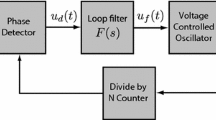Abstract
We analyze the stability of a game-theoretic based power control algorithm for optical links in the presence of time-delays. The control objective is to achieve optimal optical signal to noise ratio (OSNR) values for the signal channels. The control algorithms regularly adjust the signal powers entering the link based on a game-theoretic model. Each signal power is modeled as a player, whose goal is to maximize its own utility function. The utility function increases with an increasing OSNR value, and hence requires an increasing signal power. The trade-off is that if one player increases its OSNR value, this adversely affects the OSNR values of all of the other players. In addition to the signal powers, a dynamic price parameter is fed back to the power control algorithms. Time-delay is present for both the channel pricing parameter and the OSNR feedbacks in the link. We study the stability of the closed-loop, time-delay system. The work utilizes singular perturbation theory modified to handle Lyapunov-Krasovskii techniques.
Similar content being viewed by others
References
Ait-Hellal, O., & Altman, E. (2003). Stability of abr congestion control using the theory of delayed differential equations. International Journal of System Science, 34(10), 575–584.
Alpcan, T., & Basar, T. (2003). Global stability analysis of an end-to-end congestion control scheme for general topology networks with delay. In Proc. IEEE conf. decision and control (pp. 1092–1097), December 2003.
Fourneau, J.-M., Busic, A., Czachórski, T., & Grochla, K. (2007). Level crossing ordering of Markov chains: computing end to end delays in an all optical network. In Valuetools 2007: workshop on game theory in communication networks, Nantes, France, October 2007.
Curtain, R. F., & Zwart, H. (1995). An introduction to infinite dimensional linear systems theory. New York: Springer.
Dragan, V., & Ionita, A. (2000). Exponential stability for singularly perturbed systems with state delays. In Proc. of the 6th colloquium on the qualitative theory of differential equations (pp. 1–8), Szeged, Hungary, August 2000.
Fridman, E. (1996). Decoupling transformation of singularly perturbed systems with small delays and its applications. Zeitschrift für Angewandte Mathematik und Mechanik, 76(2), 201–204.
Fridman, E. (2002). Effects of small delays on stability of singularly perturbed systems. Automatica, 38(3), 897–902.
Fridman, E. (2006). Robust sampled-data h ∞ control of linear singularly perturbed systems. IEEE Transactions on Automatic Control, 51(3), 470–475.
Glizer, V. Y. (2004). On stabilization of nonstandard singularly perturbed systems with small delays in state and control. IEEE Transactions on Automatic Control, 49, 1012–1016.
Gu, K., Kharitonov, V. L., & Chen, J. (2003). Stability of time-delay systems. Boston: Birkhauser.
Altman, E., Tembine, H., El-Azouzi, R. (2007). Asymmetric delay in evolutionary games. In Valuetools 2007: workshop on game theory in communication networks, Nantes, France, October 2007.
Khalil, H. K. (2002). Nonlinear systems. New Jersey: Prentice Hall.
Krasovskii, N. (1963). Stability of motion. Stanford: Stanford University Press.
Liu, S., Basar, T., & Srikant, R. (2003). Controlling the Internet: A survey and some new results. In Proc. IEEE conf. decision and control (pp. 3048–3057), December 2003.
Luenberger, D. G. (1969). Series in decision and control. Optimization by vector space methods. New York: Wiley.
Mazenc, F., & Niculescu, S.-I. (2003). Remarks on the stability of a class of tcp-like congestion control models. In Proc. 42th IEEE conf. decision and control (pp. 5591–5594), December 2003.
Noble, B., & Daniel, J. W. (1988). Applied linear algebra. New Jersey: Prentice Hall.
Paganini, F., Doyle, J. C., & Low, S. H. (2001). Scalable laws for stable network congestion control. In Proc. IEEE conf. decision and control (pp. 185–190).
Paganini, F., Wang, Z., Doyle, J. C., & Low, S. H. (2005). Congestion control for high performance, stability, and fairness in general networks. IEEE Transactions on Networking, 13(1), 43–55.
Paganini, F., Wang, Z., & Doyle, J. C. (2003). A new tcp/aqm for stable operation in fast networks. In 2003 IEEE infocom (pp. 96–105).
Pavel, L. (2004). A noncooperative game approach to osnr optimization in optical networks. In IEEE conference on decision and control (pp. 3033–3038), Dec. 2004.
Pavel, L. (2007). An extension of duality to a game-theoretic framework. Automatica, 43(2), 226–237.
Stefanovic, N., & Pavel, L. (2008). A Lyapunov-Krasovskii stability analysis for game-theoretic based power control in optical networks. In Gamecomm 2008, Oct. 2008.
Stefanovic, N., & Pavel, L. (2009). A stability analysis with time-delay of primal-dual power control in optical links. Automatica, 45(5), 1319–1325.
Glizer, V., & Fridman, E. (2000). h ∞ control of linear singularly perturbed systems with small state delay. Journal of Mathematical Analysis and Applications, 250, 49–85.
Glizer, V. Y. (2009). l 2-stabilizability conditions for a class of nonstandard singularly perturbed functional-differential systems. Dynamics of Continuous, Discrete and Impulsive Systems, Series B: Applications and Algorithms, 16, 181–213.
Wang, Z., & Paganini, F. (2002). Global stability with time delay in network congestion control. In Proc. IEEE conf. decision and control (pp. 3632–3637).
Wang, Z., & Paganini, F. (2003). Global stability with time-delay of a primal-dual congestion control. In Proc. IEEE conf. decision and control (pp. 3671–3676).
Wang, Z., & Paganini, F. (2004). Improved results on global stability of network congestion control based on iterative bounding. In Proc. IEEE conf. decision and control (pp. 4205–4210), December 2004.
Wen, J. T., & Arcak, M. (2004). A unifying passivity framework for network flow control. IEEE Transactions on Automatic Control, 49(2), 162–174.
Yeganefar, N., Pepe, P., & Dambrine, M. (2007). Input-to-state stability and exponential stability for time-delay systems: further results. In IEEE conference on decision and control (pp. 2059–2064), Dec. 2007.
Zhou, K., & Doyle, J. C. (1998). Essentials of robust control. New Jersey: Prentice-Hall.
Author information
Authors and Affiliations
Corresponding author
Additional information
The authors gratefully acknowledge the support of the Natural Science and Engineering Research Council of Canada.
Rights and permissions
About this article
Cite this article
Stefanovic, N., Pavel, L. A Lyapunov-Krasovskii stability analysis for game-theoretic based power control in optical links. Telecommun Syst 47, 19–33 (2011). https://doi.org/10.1007/s11235-010-9299-x
Published:
Issue Date:
DOI: https://doi.org/10.1007/s11235-010-9299-x




